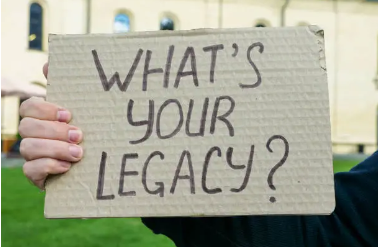
By the time they reach mid-career, research faculty have already climbed some serious mountains. From securing the first faculty position to building a productive research program and earning tenure, there’s a fair share of hard-won achievements. But at this stage, many researchers find themselves facing a quieter, more complex question:
What kind of impact do I actually want to leave behind?
That question marks a shift from productivity to purpose; from building a CV to building a legacy. And a research legacy is more than a list of one’s highest-impact papers or the sum of their grant dollars. It’s about what endures after they’re no longer in the room. It’s the ideas they helped advance. The people they trained and mentored. The norms and values they helped shape within their research group, department, and field.
Think of it this way: Legacy is the move from being a high-output researcher to becoming a strategic architect of long-term impact. That requires stepping back to ask:
-
What am I known for—and what do I want to be known for?
-
What has my work enabled for others?
-
What story is my research telling over time?
Redefining Success: From Metrics to Meaning
In the early-career phase, it’s all about producing: publish, get funded, repeat. This is understandable since publications and funding are often organizational performance metrics that contribute to P&T decisions. But legacy-building begins when we start framing our work in terms of outcomes rather than outputs.
For example:
-
An output is a paper that lands in a top-tier journal.
An outcome is a method that becomes the gold standard in the field. -
An output is a funded R01.
An outcome is work that catalyzes an entirely new line of research, by one’s own team and others.
The shift from what we do to what we enable is subtle, but transformative. Even small tweaks to how we frame our planning sessions, grant proposals, and annual reviews can start reinforcing this mindset. The goal is to focus not just on what we’ll do, but why it matters, and who it influences.
Mentorship: Legacy in Progress
Some of our most lasting contributions may not be in our publications but in our people: The postdoc who launches a new startup. The trainee who carries our values forward into their own group. The mentee who says, “You’re the one who made me believe I could do this.” That’s legacy in progress.
trainee who carries our values forward into their own group. The mentee who says, “You’re the one who made me believe I could do this.” That’s legacy in progress.
How do you get there? Intentional mentorship. This means:
-
Nurturing strengths beyond the project: Help your people grow as researchers and as professionals.
-
Creating visibility and opportunity: Nominate mentees for awards. Give them the recognition. Let them lead.
-
Offering ownership: Let them take a project from idea to execution. Let them experience the wins and the risks.
Your academic descendants and their impacts are a key part of your legacy.
Culture: The Most Underestimated Form of Legacy
Many PIs think of culture as a soft or secondary concern—something nice to have once the research is running smoothly. But the truth is, culture often determines whether the research runs at all, and how it evolves over time.
By mid-career, most PIs have shaped the tone and practices of their lab or research group, whether they meant to or not. They’ve made decisions, formal and informal, about how people collaborate, how mistakes are handled, what gets rewarded, and whose voices carry weight. These norms affect productivity and shape how people feel about doing research in the first place.
Culture doesn’t stop at the lab door. As senior members of their departments or institutions, mid-career faculty often hold influence on setting expectations—what counts as rigorous, what counts as ethical, and what counts as leadership.
If you’re not already doing so, this is a good moment to take a look around and ask:
-
What’s it like to be part of my research group?
-
Do early-career researchers feel they can take intellectual risks?
-
Is collaboration the default—or competition?
-
Are rigor and reproducibility baked into everyday habits—or just discussed in theory?
If any of those answers feel out of sync with your values, you’re in a position to change that. You can set clearer expectations. Invite more open discussion. Reward both outcomes and process. The tone you set now—intentionally or unintentionally—will echo in the next generation’s approach to research. When you lead with integrity, curiosity, and clarity, your culture becomes a legacy in its own right.
Think in Programs, Not Projects
At some point in mid-career, many PIs realize that while they’ve published a lot, the work doesn’t quite cohere. It’s a productive portfolio, but perhaps not yet a recognizable professional identity.
This is where stepping back can help. When we pause to look at the larger arc of our work, we often start to see the thread running through it: the big question that keeps pulling us back, or the persistent challenge that our work keeps circling.
This is the difference between a collection of projects and a research program. The former gets work done; the latter builds momentum and makes a field take notice.
If you haven’t already, consider:
-
What connects my work over the last decade?
-
What am I uniquely positioned to explore in the next one?
-
What’s the question that’s big enough to matter and specific enough that I’m the one to tackle it?
As you clarify your programmatic narrative, it becomes easier to explain your impact to funders, collaborators, and future team members. While advancing knowledge, you’ll also be shaping how others think about the problem space itself.
Strategic Collaboration: Relationships That Outlast Roles
Legacy isn’t built in isolation. And by mid-career, most faculty have realized that some of their most influential work came from who they worked with, not just what they worked on.
But strategic collaboration is more than networking. It’s about building relationships that bring out your best ideas, challenge your assumptions, and align with your values.

At this stage, it’s worth asking:
-
Who are the people who push my thinking?
-
Which collaborators have complementary strengths that elevate the work?
-
Where can I invest in long-term partnerships that reflect not just shared interests, but shared priorities around mentorship, equity, and quality?
Collaborations like these can produce great work and create resilient networks that extend our influence and broaden our reach. The relationships we build can become one of the most durable parts of our legacy.
Legacy Can Happen Organically AND Intentionally
Some people have natural strengths in connecting with others and building relationships, and to the rest of us it can look like an effortless legacy in progress. That doesn’t mean it actually is effortless; those individuals are still frequently making choices about how they spend their time and in whom they invest. So, while legacy will happen no matter what, it is possible to approach this with intention. WE get to decide what we prioritize, who we invest in, how we lead, and what we stand for.
What better time than now?
Feeling stuck? Want help reshaping your legacy? Let us know!
